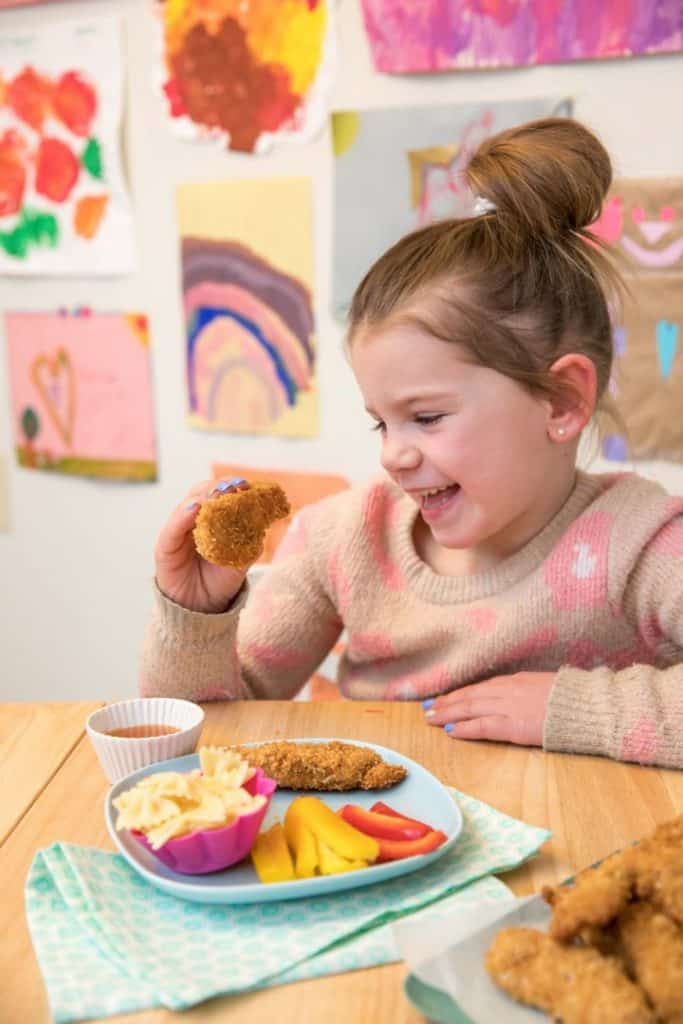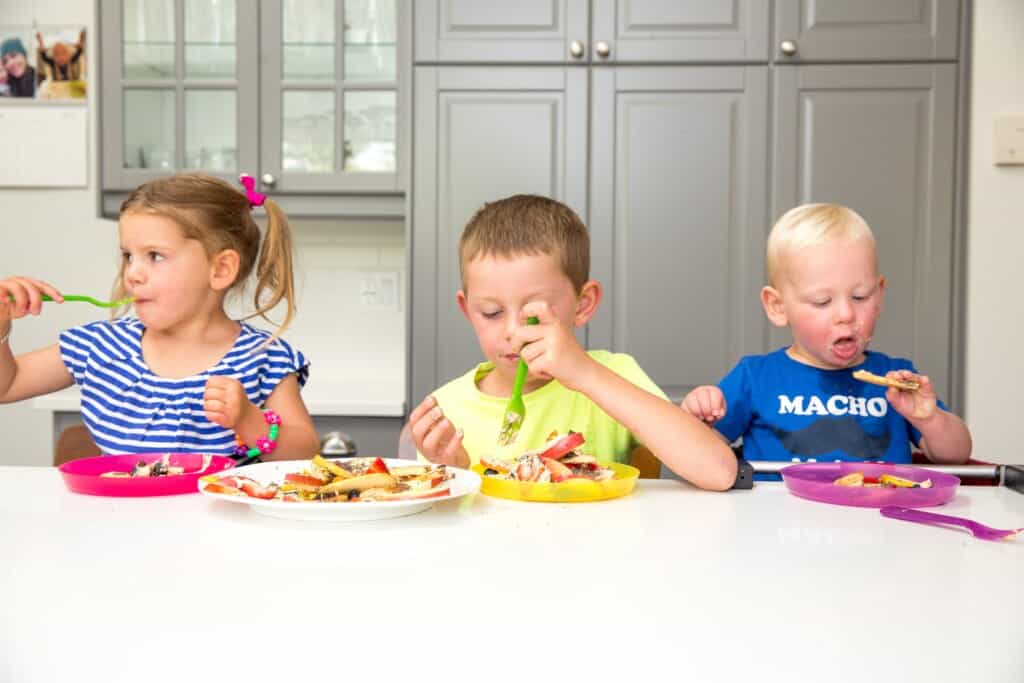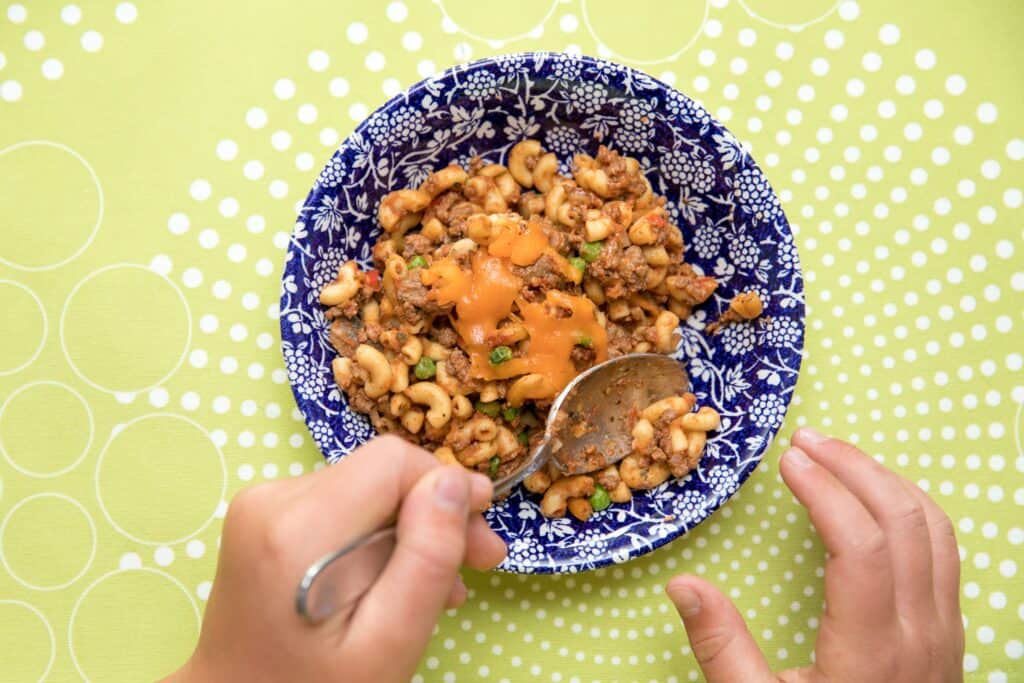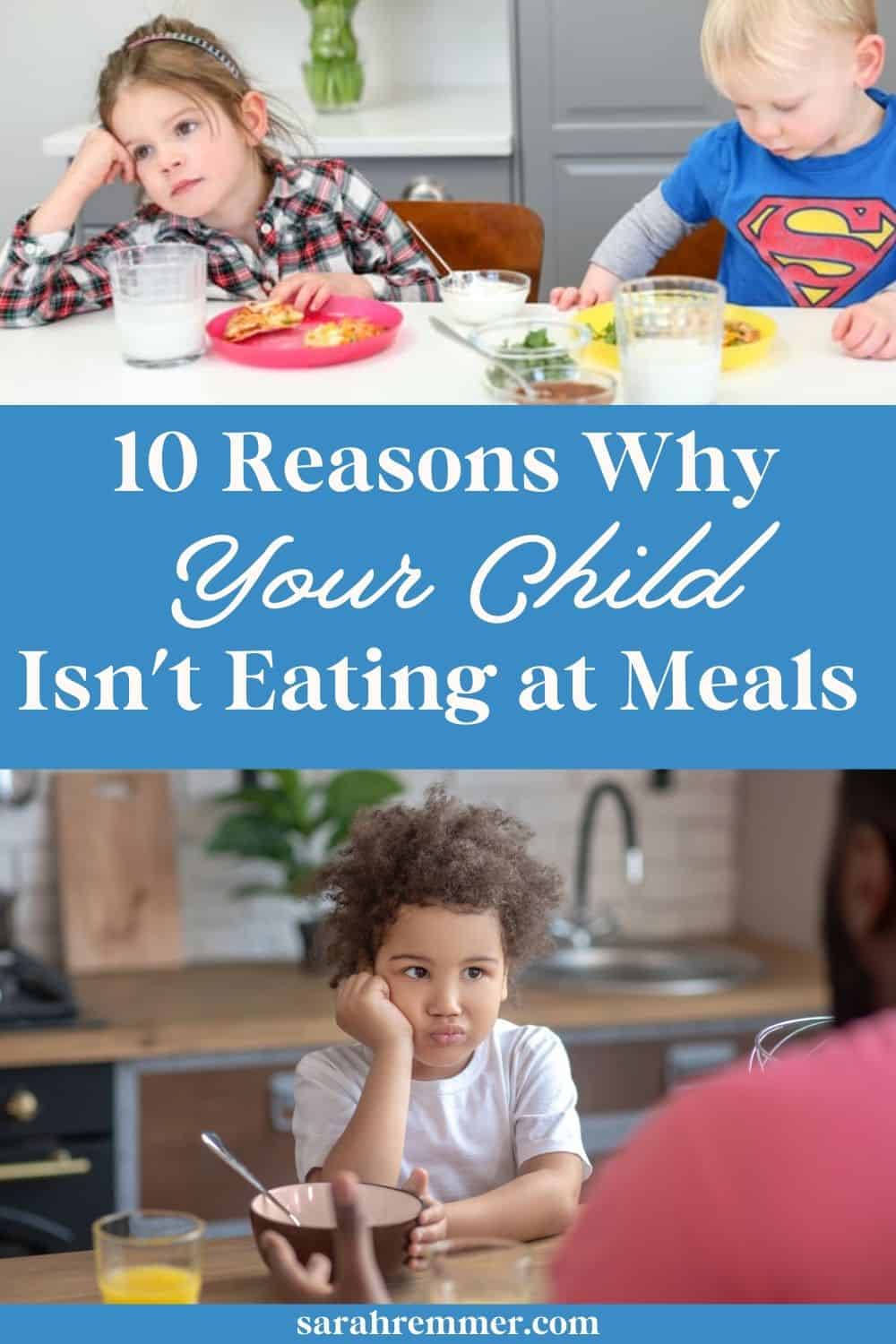Why Are Kids More Sccepting of Foods When They Feed Themselves
The reasons why a child between the ages 2-5 refuses to eat might surprise you. The good news is, making a few simple adjustments can change everything!

If you'd like to learn more about this topic in a visual way, check out my Google web stories on 5+ reasons your child refuses to eat and what to do!
As frustrating as it is, food refusal is 100% normal
There's nothing quite as frustrating and defeating as spending time prepping, cooking, and serving a meal, only to have your child refuse to eat.
Having three kids myself, and knowing the importance of nutrition for growth and development (after all, I am a pediatric dietitian), I know just how hard this can be.
As much as we want to micromanage our child's food intake though, doing so creates major power struggles, mealtime meltdowns and stress for everyone.
Here's the thing:
Kids' eating patterns are random, unpredictable and all over the map. That's why it's so important not to go into mealtimes with an agenda, and focus on what you CAN and SHOULD control. Before diving into the 10 common reasons a child refuses to eat, let's go over division of responsibility in feeding.
Division of responsibility in feeding (sDOR)
I'm a big fan of the division of responsibility in feeding (sDOR).
This philosophy comes from Ellyn Satter, who is a childhood feeding expert and author. Her strategy has been heavily researched and has been proven over and over and over again to work wonders with families and children.
The sDOR distinguishes between a parent/caregiver's responsibilities in feeding and the child's responsibility:
Parents/caregivers are in charge of:
- What is served
- When it's served
- Where it's served
Kids are in charge of:
- Whether they eat
- How much they eat
As simple as it sounds, this philosophy will transform your mealtimes. I promise!
99% of picky eating issues stem from the sDOR not being followed. And with good intention, well-meaning parents go into meals with an agenda, and believe it's their job to "get their child to eat".
Repeat after me: "It's NOT my job to get my kid to eat".
Sarah Remmer, RD
When we start to feel frustrated and defeated in the face of picky eating, we can often resort to techniques such as:
- Bribing : "if you eat three more bites of broccoli you can have dessert"
- Shaming: "your brother always eats his vegetables, so why can't you?!"
- Punishing: "no TV tonight for you because you didn't eat all of your dinner"
- Forcing: "you cannot get down from the table until you have had two more bites"
- Distracting: "you can watch your favorite show while you eat your dinner"
These may act as short-term solutions, but they can negatively affect our kids' eating and nutrition long term. Although these tactics are extremely tempting, especially when you've witnessed your little one finally eat a decent portion of their meal as a result, looking through your "short-term feeding lens" ("I just want him to eat his meal!") actually sets your child up for failure later on.
Overtime, kids stop trusting their own physical hunger cues and become less intuitive, relying more on external cues to tell them what to eat, and picky eating habits become worse.
How to set up kids up for eating success
The more pressure they feel, the less likely they'll eat and enjoy mealtimes.
This is the opposite of what we want as parents.
We want to nurture our child's natural ability to eat intuitively. We want our kids to trust their bodies and learn how to self-regulate. We want our kids to have a healthy long-term relationship with food.

Understanding why a child refuses to eat
To give you some context into why your child may be refusing to eat, I've listed the 10 most common reasons a child refuses to eat below (and some possible solutions).
Like I mentioned earlier, kids' eating patterns are all over the place and there are so many factors that play into if and how much they eat.
As long as you:
- follow the sDOR
- focus on your responsibilities as the parent (what, when and where)
- keep mealtimes as positive and pleasant as possible, and
- focus on your own meal
you're doing your job as the child's parent/caregiver!

10 common reasons a child refuses to eat at meals
- They feel pressure
- They feel that they have no say
- They're bored
- They're simply not hungry
- They're distracted
- Portions are too big
- They're not feeling well
- Too much milk (or juice)
- There are too many snacks
- They're too tired
1. They feel pressure
If a child feels pressure to eat or senses that you as the parent are anxious at mealtimes, they will likely back off and not eat.
Toddlers and young kids sense pressure, even if it's not as direct as "eat your peas!" If you focus too much on what and how much they're eating during a meal instead of allowing them to simply be another eater at the table (while you focus on your own meal), they'll become anxious and likely resist eating.
Perhaps you:
- push food closer to them
- watch them every move
- hover over them
- continually take uneaten food off of their tray and replace it with new food
- talk about their lack of eating
- try to spoon-feed them
these are all forms of indirect pressure.
How to fix it:
Let your toddler self-feed and eat at their own pace at meals, provide lots of food variety at meals in manageable amounts, and let them be in charge of whether and how much they eat. Try your best not to hover over your child. I know–it's hard not to when they hardly touch their food. Sit back and engage in conversations with the whole family, including your child.
If you can think about mealtime more as "family bonding time" than "get my kid to eat time", your child won't feel as pressured and will be more open to trying new or previously rejected foods.

2. They feel that they have no say
We know from research that kids eat better when they have a hand in helping with shopping, preparing, cooking or serving their meal.
That's why it's important to include kids in meal prep–even getting them to mix together ingredients or set the table can help. And even though parents should ultimately be in charge of the "what's" of feeding, kids might feel as though they have no control or say over what they're fed if you don't include them in choosing foods once in a while.
They may grow bored of what you serve them, or perhaps they don't like the way their food is plated.
How to fix it:
It's important to set healthy boundaries and uphold your responsibility of "what, when and where", but it's also ok to let your kids be a part of the process.
Get them involved in shopping, prepping, menu planning, cooking, serving and cleaning up! I never thought I'd say this, but my kids love packing their lunches now using their Fenigo leak-proof lunchbox sets. They also love these zero waste lunchbox accessories, too.
Yes, involving your kids can make the process a bit longer and maybe a bit more frustrating, but the benefits are huge and it's worth it.
Try serving meals family-style (sort of a like a deconstructed meal!). Place all of the ingredients on the table and let your kids build their own meal. This still allows you to be in charge of what is served, but gives your kids a sense of independence and control. This strategy works really well with meals like tacos, yogurt parfaits, pasta nights, stir-fries, homemade pizza, buddha bowls and oatmeal "sundaes".
3. They're bored
I'm like any parent and get stuck in "food ruts" where I serve the same thing over and over again. Translation: major kid boredom and eventual food refusal.
Here's an example: after my third baby was born, I felt as though I was in survival mode for a few months (I still do sometimes!) and sent my son to school with the same snack pretty much every day: a healthy granola bar, cheese or yogurt and a piece of fruit. Yep, the same thing over and over again. He started coming home with most of his snack uneaten not just once, but pretty much every day.
In my sleep-deprived state, I didn't realize that he could be growing tired of his snack, even though he used to love it.
How I fixed it:
I asked him why he wasn't eating his snack and he said "I don't know, I just don't like it any more". I then asked him if he was bored of it and he replied "yes I'm bored of it".
We then came up with a few new and different snack option for him together and I try to rotate through three or four of them so that he doesn't get bored. We get bored of certain foods and so do our kids. This is usually an easy challenge to overcome.
Switch up serving styles. Something as simple as changing the shape or texture of food can make a difference to a child. If raw cauliflower, carrots or celery are too crunchy, steam them. Mix cucumber "coins" with strips, or try sweet potato "fries" instead of roasted sweet potato, or butternut squash soup instead of baked butternut squash! Experiment to see what they like best.
4. They're simply not hungry
We now know that toddlers' and kids' appetites can be unpredictable and erratic at the best of times. After the age of two, growth slows and stabilizes which means that toddlers aren't as hungry as they used to be.
Kids have "hungry days" and "full days" and that could mean that one day, your child out-eats everyone at the table, and another day they doesn't eat much at all at his dinner.
As long as you're maintaining your feeding roles and staying consistent with mealtime boundaries, your child should be in charge of whether and how much they eat. It is possible that your child is simply not physically hungry when a meal is served (for whatever reason) and that's ok.
How to fix it:
Try to accept "I'm just not hungry" as an acceptable answer, and remind your child that the kitchen will be closed after mealtime.

5. They're distracted
Allowing your kids to watch TV, watch an iPad, or play with toys at the table is a recipe for distraction.
When a child is watching a show or playing a game on an iPad while eating, they are focusing most, if not ALL, of their attention on screen. There is no attention left for eating their meal, let alone listening to their tummy. With a screen in front of them, kids will can easily under or over-eat because they're just not paying attention.
Young kids have a hard enough time focusing on their meal with minimal distractions let alone a big shiny moving screen in front of them. The same goes for toys and playing with siblings at the table.
How to fix it:
No toys at the table and no eating in front of the TV (that goes for parent too—no phones at the table!).
Many well-meaning parents depend on screens or toys to distract their child into eating two or three more bites, but this is counter-productive and can make the problem worse (and create a pesky, hard-to-break habit!). Screens and other distractions interfere with a child's ability to self-regulate and tune in to their appetite.
6. Portions are too big
Some kids are turned off of a meal simply because the portion that they've been served is too large and overwhelming.
This was never a problem with my oldest son, but is definitely a problem with my daughter. I used to serve her the same amount that I served my son (this was a mindless habit that I got into), but then after many meal rejections, realized that I was serving her too much. We were wasting food and my daughter was overwhelmed with the portions that I was offering.
How I fixed it:
When I cut her portions down (by more than one half!), she started eating her meals again and sometimes even asked for more.
I served her less of everything, but still made sure that she was getting a nice balanced meal. I realized that I am like this too–if I'm served too large of a portion of any food, I immediately become turned off and don't eat as much.

7. They're nervous or scared to try it
Imagine trying a foreign food for the first time, without knowing how it tastes or feels in your mouth. You might be tentative too! Kids have more taste buds than we do too, so all foods have a more intense taste for them.
How to fix it:
Try the tester plate! Try introducing a tester plate to sit next to your child's real plate or bowl. This is reserved for those foods that are unfamiliar, scary, or "yucky." Kids don't have to eat or even taste the foods on this plate, but they can touch them, smell them, mush them, stack them, lick them, or even taste and politely spit them out. It's a safe and fun way to explore the food without actually eating it. And it brings kids 1 step closer to eventually accepting them later on! The other option is just making sure that foods are separate on their plate. Some kids don't like foods touching one another so going with a divided plate can work well too. This is my favourite one.
Acknowledge their bravery. Parents often praise their kids for trying new foods or eating certain amounts. Although well intentioned, overpraising at meals sends the wrong message. We want our kids to eat intuitively and to learn to love a variety of foods in their own time.
Instead of praising, notice and acknowledge your child's bravery when trying something new by saying something like, "That was so brave of you to try the broccoli tonight!" It will boost their confidence and increase the likelihood of your child being more adventurous with other foods too.
Try a "tester plate" for unfamiliar or previously rejected foods. It often works like a charm!
Sarah Remmer, RD
8. Too much milk (or juice)
Between-meal-milk-drinking can have a satiating effect. Milk contains fat as well as protein, two nutrients that make kids feel full. Too much milk can displace other important nutrients too, filling precious tummy space that should have room for a variety of different foods.
Too much milk and juice can also negatively affect dental health.
How to fix it:
Toddlers and children should be offered no more than 500mL (two cups) of milk per day. Try offering half a cup at each meal (or right after), which leaves room for another half cup before bedtime if that is part of your routine. Water should be the only fluid offered between meals for hydration.
Juice contains excess calories and sugar that children don't need – it fills them up with little nutritional value. Did you know that a 250 mL (1 cup) juice box contains six teaspoons of sugar?
If your children drink juice, limit it to no more than 125 mL (1/2 cup) per day and water it down (and offer at meals with food).

9. There are too many snacks
Kids who "graze" between meals often, or snack randomly throughout the day may come to the table feeling too full to eat their meal.
This is why it is so important to establish structure around snack times.
How to fix it:
There should be a designated snack time where one or two foods of the parent's choosing (such as yogurt and fruit or cheese and crackers) are offered, rather than snacking being a random free-for-all in between meals.
Toddlers and young kids need to be given the chance to build an appetite for meals, otherwise, they won't eat much and it will be harder for them to learn self-regulation. This not only disrupts family mealtimes, but can also affect a child's nutritional intake and overall relationship with food over time.
10. There's a real medical reason affecting your child's ability to eat
It is possible that there is a real, physical or medical concern affecting your child's ability to eat. Here's 4 legit reasons for picky eating:
Eating is uncomfortable
Eating may actually hurt your child, if there is an underlying medical concern. This could be caused by food allergies, reflux, eosinophilic esophagitis (painful erosions in the esophagus), or severe constipation. Other non-food related conditions that affect comfortable eating are breathing or muscle movement conditions (congenital heart defects, severe asthma, or muscular dystrophy).
Eating feels weird
Kids with sensory integration issues may be more sensitive to tastes, textures, smells and even the sight of food (they just feel more intense!). Sometimes, they simply can't feel food in their mouth (this is where food pocketing may come in) or they only feel comfortable eating foods with a uniform texture (only crunchy or only smooth).
Eating is just too hard
When oral-motor control and function are compromised, such as with a cleft palate or with malformations of digestive or oral muscles (trachea or esophagus, tongue), eating can be really really tough and painful. Not to mention severe dental issues, enlarged adenoids and tonsils. Ouch! In some of these cases, it is worth seeking professional help from a qualified speech language pathologist, especially if your child can't chew, or swallow solid foods comfortably by about 15 months.
Eating is scary
Kids who experience trauma while eating — even with no history of picky eating — may refuse to eat (especially the particular food culprit). Think choking, or maybe an experience where a child was forced to eat. Or maybe they got sick (vomited), felt extremely nauseous afterward, or inhaled (aspirated) a food. All of these experiences can make food "scary."
How to fix it:
If you think this might be the case, it's important to consult with your child's doctor and request a referral to a qualified Speech Language Pathologist, Occupational Therapist and/or Paediatric Registered Dietitian who specialize in feeding issues.
Did you know that we offer personalized nutrition counselling for kids and families? If this is something you'd like to learn more about, please visit The Centre for Family Nutrition.

Source: https://www.sarahremmer.com/10-reasons-why-your-child-refuses-to-eat-and-what-to-do/
0 Response to "Why Are Kids More Sccepting of Foods When They Feed Themselves"
Post a Comment